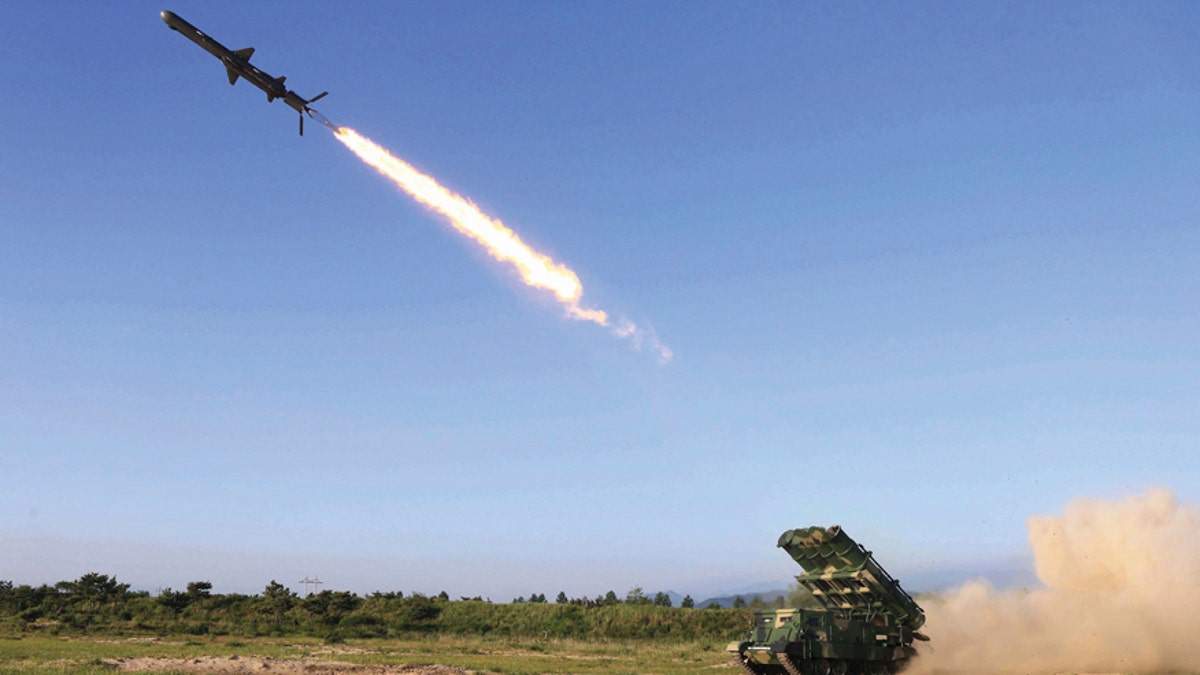
This undated photo distributed on Friday, June 9, 2017, by the North Korean government, shows a test of a new type of cruise missile launch at an undisclosed location in North Korea - file photo. (Korean Central News Agency/Korea News Service via AP)
Maneuvering cruise missiles, fast-moving stealthy fighter jets, armed drones, long-range helicopter-fired air-to-ground weapons and hypersonic rounds traveling at five times the speed of sound are all modern methods of air-attack able to destroy Army ground war units -- potentially even rendering them inoperable or, even worse, making them vulnerable to complete destruction.
The weapons, sensors and platforms now operated by potential adversaries have created an entirely new tactical environment now defining land combat, a scenario that has inspired the U.S. Army to fast-track new, advanced air and missile defense radar technologies sufficient to thwart this changing sphere of enemy attack possibilities.
The service is now surging forward in response to an urgent need with a new 360-degree radar system called Lower Tier Air & Missile Defense Sensor (LTAMDS), slated for initial fielding by 2022. Unlike the more linear directional configuration of the existing Patriot air and missile defense system, the Raytheon-built LTAMDS is engineered with overlapping 120-degree arrays intended to seamlessly track approaching threats using a 360-degree protection envelope.
PENTAGON DEPLOYS NEW SUB-LAUNCHED, LOW-YIELD NUCLEAR MISSILE
“The Lower Tier Air and Missile Defense Sensor will deliver sensor capability to counter advanced threats and take full advantage of the Patriot Missile Segment Enhancement (Patriot upgrade) capability. It will provide significant improvement over the Patriot radar while enabling incremental growth,” Natalia Thaniel, director of communications, Army Futures Command, Air and Missile Defense Cross Functional Team, told Warrior in a statement.
The Patriot, well-known for its Gulf-War ability to track and destroy Saddam’s Scud missiles, has been brought into the modern area through a series of extensive upgrades. The kinetic-energy hit-to-kill Patriot Advanced Capability weapon in particular, has received new software, modern sensors and a special upgrade called Missile Segment Enhancement. The Patriot still has a lot of capability, and can defend against the threats of today and tomorrow. However, a new radar is needed to defend against the threats warfighters will face the day after tomorrow.
Nevertheless, while the Patriot continues to remain operational and effective in many respects, the decades-old system will start facing challenges when it comes to confronting increasingly advanced-kinds of attacks.
SOLDIERS USE AI TO FIRE PRECISION GRENADES, GUIDE DRONE ATTACKS
“The battlefield is not linear. What has happened is threat development. Every time we adapt, potential enemies do something to their threat systems. Cruise missiles, for example, do not have to fly in a straight line,” Bob Kelley, Raytheon's director of IAMD (Integrated Air and Missile Defense) Domestic Programs for Business Development & Strategy, told Warrior in an interview. “The threats are so advanced, we decided we would need something brand new.”
The rapid engineering of LTAMDS, accelerated by the Army and Congress, could well be described as the technical or material manifestation of the Army’s strategic approach outlined in the Army Air & Missile Defense 2028 Vision document. The essay specifies some of the more challenging specifics associated with newly emerging drone, helicopter, aircraft and ballistic missile threats. For instance, regarding ballistic missile threats, the Army Vision essay explains that advanced weapons are now engineered with “countermeasures, maneuverable re-entry vehicles, multiple independent reentry vehicles, hypersonic/supersonic glide vehicles and electronic attack.”
Increased maneuverability is also, according to the Army document, a specific concern regarding modern cruise missiles.
ARMY TO TEST AND SHOOT WEAPONS AT NEW MOBILE PROTECTED FIREPOWER PROTOTYPES
“Numerous countries are developing ground-, sea-, and air-launched land-attack CMs using an assortment of unconventional and inexpensive launch platforms. In addition, long-range, low-observable, advanced CMs enable our adversaries to present a complex air and missile defense problem with high-volume, high-precision missiles capable of 360-degree avenues of approach,” the Army Vision document states.
CLICK HERE TO GET THE FOX NEWS APP
Raytheon engineers recently completed the first round of indoor testing of its LTAMDS antenna, assessing the antenna’s ability to track multiple threats simultaneously. The new LTAMDS antenna, Raytheon developers explain, is similar in size to the Patriot yet twice as sensitive. To conduct further testing, the array will be mounted onto a precision-machined enclosure.




















